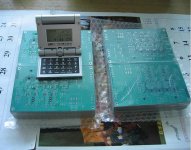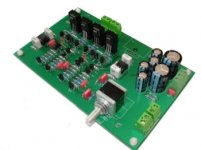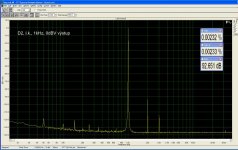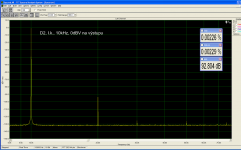PMA said:The input stage does not behave much like standard LTP - remeber you do not know the resistor values, that are key factor to this preamp. Also, see small difference between Adiff and Acl - there is nothing to keep very low DC without servo. In case you afford DC offset like 100mV - 300mV, then you do not need the servo. I want the servo, and I see no sonic problem when it is applied.
Hi Pavel. Would you be kind to explain why isn`t "LTP" biased with CCS and what`s the benefit of using resistor instead?
Nope, I do not know the resistor values but I can make an educated guess 😉 I have a similar design made during 2007-2008.
I was only curious to know what the mechanisms behind the large DC-offset are. Mismatched transistors and no pot for DC adjustment maybe.
Not that I mind a well-made DC-servo but if I can make it without one, I will do that.
Sigurd
I was only curious to know what the mechanisms behind the large DC-offset are. Mismatched transistors and no pot for DC adjustment maybe.
Not that I mind a well-made DC-servo but if I can make it without one, I will do that.
Sigurd
PMA said:The input stage does not behave much like standard LTP - remeber you do not know the resistor values, that are key factor to this preamp. Also, see small difference between Adiff and Acl - there is nothing to keep very low DC without servo. In case you afford DC offset like 100mV - 300mV, then you do not need the servo. I want the servo, and I see no sonic problem when it is applied.
Hi
I think I have been asleep....but can I purchase a PCB? What is the cost and do you accept paypal?
Lastly is there a BOM that goes with it?
regards
Rob
I think I have been asleep....but can I purchase a PCB? What is the cost and do you accept paypal?
Lastly is there a BOM that goes with it?
regards
Rob
robmil;
I happens to know that PMA is on a vacation trip, so you might have some patience to get a reply.
I happens to know that PMA is on a vacation trip, so you might have some patience to get a reply.
This board looks really, really good. I've read most of the thread and the techno details sound really good too. I'm going to e-mail PMA and get on his order list. I realize that he may still be on vacation. I can wait. Thanks, DANA.
Looking forward to your impressions Jan.
Crazy workload is preventing me from starting on mine, but I do expect it to be a cracker.
I guess you'll also do some measurements?
Crazy workload is preventing me from starting on mine, but I do expect it to be a cracker.
I guess you'll also do some measurements?
Hello all,
at the moment all the boards are sold out, unfortunately. I have to assemble more than 20 modules now, it would take my time till mid August at least. After the modules are assembled, I may consider production of further PCBs.
A colleague of mine, who has better measuring equipment (AP1 as generator, good soundcard as analyzer), has measured his Dispre II at 1kHz and 10kHz. Hereby the result for 1kHz, 1Vrms, 1kohm :
at the moment all the boards are sold out, unfortunately. I have to assemble more than 20 modules now, it would take my time till mid August at least. After the modules are assembled, I may consider production of further PCBs.
A colleague of mine, who has better measuring equipment (AP1 as generator, good soundcard as analyzer), has measured his Dispre II at 1kHz and 10kHz. Hereby the result for 1kHz, 1Vrms, 1kohm :
Attachments
Thanks, in these measurements, at higher harmonics, both generator and opamps used in the soundcard make difference, it was verified.
I am glad that distortion at 1kHz and 10kHz is almost same, the result of fast circuit, that is not slew rate limited.
I am glad that distortion at 1kHz and 10kHz is almost same, the result of fast circuit, that is not slew rate limited.
PMA said:I am glad that distortion at 1kHz and 10kHz is almost same, the result of fast circuit, that is not slew rate limited.
I don't think it's the result of a "fast circuit, that is not slew rate limited" but because of the large OLG. This provides about the same amout of NFB at 2k, 3k,... and 20k, 30k,... to decrease the distortions. A large (small signal) OLG may or may not be correlated with a high slew rate and, although stupid, it is possible to build an amp with a large (small signal) OLG but with poor (large signal) slew rate. Such an amp will have the distortions vs. output level rapidly increasing and a significant amount of DIM/TIM/PIM/etc... at high output levels.
Why don't you measure the distortions at 20k as well? I think adding that information will offer more insight on how your amp is performing.
And I have to ask this again: while I am not impressed at all by 20ppm @ 10KHz, how/why is your preamp better than an opamp based design having distortions under 0.1ppm @ 20KHz and 300V/us slew rate, in less than half the size of your preamp and about half the cost? Short of a blank "it sounds better", of course...
The board looks really nice, good luck with your business!
but because of the large OLG.
Che? What do you consider a large OLG, can you put some figures behind your statement ?
MRupp said:
Che? What do you consider a large OLG, can you put some figures behind your statement ?
Sorry, I've meant "small signal bandwidth" instead of "small signal OLG".
Thanks for the heads-up.
- Home
- Source & Line
- Analog Line Level
- New DISPRE preamp, successor to previous popular version



